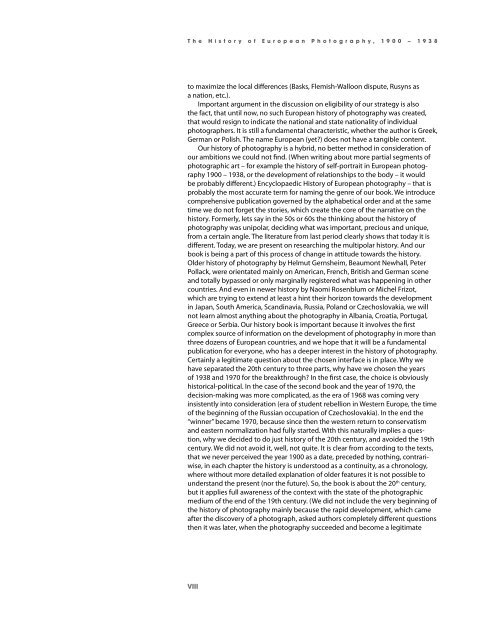T h e H i s t o r y o f E u r o p e a n P h o t o g r a p h y , 1 9 0 0 – 1 9 3 8
T h e H i s t o r y o f E u r o p e a n P h o t o g r a p h y , 1 9 0 0 – 1 9 3 8
T h e H i s t o r y o f E u r o p e a n P h o t o g r a p h y , 1 9 0 0 – 1 9 3 8
You also want an ePaper? Increase the reach of your titles
YUMPU automatically turns print PDFs into web optimized ePapers that Google loves.
The History of European Photography, 1900 <strong>–</strong> 1938<br />
to maximize the local differences (Basks, Flemish-Walloon dispute, Rusyns as<br />
a nation, etc.).<br />
Important argument in the discussion on eligibility of our strategy is also<br />
the fact, that until now, no such European history of photography was created,<br />
that would resign to indicate the national and state nationality of individual<br />
photographers. It is still a fundamental characteristic, whether the author is Greek,<br />
German or Polish. The name European (yet?) does not have a tangible content.<br />
Our history of photography is a hybrid, no better method in consideration of<br />
our ambitions we could not find. (When writing about more partial segments of<br />
photographic art <strong>–</strong> for example the history of self-portrait in European photography<br />
1900 <strong>–</strong> 1938, or the development of relationships to the body <strong>–</strong> it would<br />
be probably different.) Encyclopaedic History of European photography <strong>–</strong> that is<br />
probably the most accurate term for naming the genre of our book. We introduce<br />
comprehensive publication governed by the alphabetical order and at the same<br />
time we do not forget the stories, which create the core of the narrative on the<br />
history. Formerly, lets say in the 50s or 60s the thinking about the history of<br />
photography was unipolar, deciding what was important, precious and unique,<br />
from a certain angle. The literature from last period clearly shows that today it is<br />
different. Today, we are present on researching the multipolar history. And our<br />
book is being a part of this process of change in attitude towards the history.<br />
Older history of photography by Helmut Gernsheim, Beaumont Newhall, Peter<br />
Pollack, were orientated mainly on American, French, British and German scene<br />
and totally bypassed or only marginally registered what was happening in other<br />
countries. And even in newer history by Naomi Rosenblum or Michel Frizot,<br />
which are trying to extend at least a hint their horizon towards the development<br />
in Japan, South America, Scandinavia, Russia, Poland or Czechoslovakia, we will<br />
not learn almost anything about the photography in Albania, Croatia, Portugal,<br />
Greece or Serbia. Our history book is important because it involves the first<br />
complex source of information on the development of photography in more than<br />
three dozens of European countries, and we hope that it will be a fundamental<br />
publication for everyone, who has a deeper interest in the history of photography.<br />
Certainly a legitimate question about the chosen interface is in place. Why we<br />
have separated the 20th century to three parts, why have we chosen the years<br />
of 1938 and 1970 for the breakthrough? In the first case, the choice is obviously<br />
historical-political. In the case of the second book and the year of 1970, the<br />
decision-making was more complicated, as the era of 1968 was coming very<br />
insistently into consideration (era of student rebellion in Western Europe, the time<br />
of the beginning of the Russian occupation of Czechoslovakia). In the end the<br />
“winner” became 1970, because since then the western return to conservatism<br />
and eastern normalization had fully started. With this naturally implies a question,<br />
why we decided to do just history of the 20th century, and avoided the 19th<br />
century. We did not avoid it, well, not quite. It is clear from according to the texts,<br />
that we never perceived the year 1900 as a date, preceded by nothing, contrariwise,<br />
in each chapter the history is understood as a continuity, as a chronology,<br />
where without more detailed explanation of older features it is not possible to<br />
understand the present (nor the future). So, the book is about the 20 th century,<br />
but it applies full awareness of the context with the state of the photographic<br />
medium of the end of the 19th century. (We did not include the very beginning of<br />
the history of photography mainly because the rapid development, which came<br />
after the discovery of a photograph, asked authors completely different questions<br />
then it was later, when the photography succeeded and become a legitimate<br />
VIII


